Jazz Communities and Social Influence

In 2007 I became interested in musician communities and how they think. Since I was starting to feel like I was a part of a jazz community in Chicago, I used my resources to write a dissertation that uncovered some truisms about cognition and jazz musicians. When I got to Chicago, younger musicians were coming together to create music series at notable venues on the North Side of the city, including the Bad Dog Tavern, Silvie’s Lounge, and Muse Café. Some had been established in previous years (e.g. Hungry Brain) and were influences for these newer series.

The Bad Dog Tavern (Monday night music series)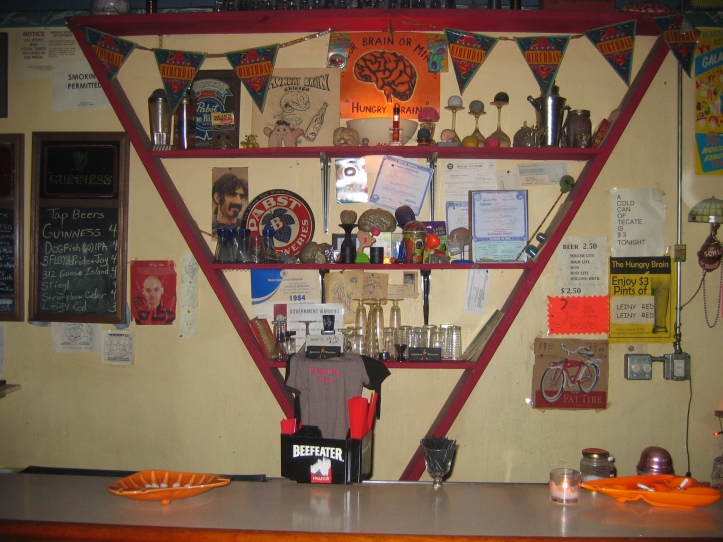
The Hungry Brain (Sunday Night Transmission Series)
Northwestern University was a good place for my research, especially with cognitive psychologist Douglas Medin at my finger tips. He has contributed countless articles over the years about the psychology of categorization and reasoning in various cultural systems (Medin & Atran, 2004; Unsworth & Medin, 2005; Medin et al., 2006). One of the interesting directions of this work is that it allows us to understand how categorization influences our morals of decision-making (Medin et al., 2007). Doug, in addition to Richard Ashley and Robert Gjerdingen, helped me shape my ideas into what became a study of cognition amongst jazz communities in Chicago (Anson-Davis, 2010). My outlook on this topic has been somewhat colored by my recent shift to playing rather than analyzing music. So, what you will see here is the beginning stages of my dissertation – how jazz musicians talk about the music that influences them. I should also mention that some of these ideas were presented at the Society for Music Perception and Cognition Conference in 2007.
We can learn a lot about cognition from the way people arrange things they care about. How do musicians organize their influences? Musicians spend hours transcribing music from their favorite recordings: not just writing the music down, but playing alongside the original recording (Liebman, 2011). The amount of time and effort put into this process demonstrates the importance of these influences, but how are they cognitively organized?
Doug Medin used this research technique with regard to fish instead of music. Generally this world of psychological anthropology describes culture as “causally distributed patterns of ideas, their public expressions, and the resultant practices and behaviors in given ecological contexts” (Medin et al., 2007, p. 28). Specifically, Doug’s lab found that Menominee native and majority (Caucasian) fishing practices were vastly different in some regions of Wisconsin, and wanted to uncover the basis for this conflict (Medin et al., 2006). Each informant was asked to sort cards with fish names on them in this manner: “put the fish that go together by nature into as many groups as you want” (p. 247). Here are their some of their results:


Among other methods of analysis, multi-dimensional scaling (MDS) showed that these cultural groups “share a common model of fish,” but, “the Menominee…share a somewhat distinct conceptual organization of fish” (p. 249). Thus, the two dimensions that mattered to all fisherman informants were desirability and characteristic adult size, but Menominee also cared about habitat. These differences might relate to the conflict that arises when the Menominee notice the lack of certain fish in their native waters; majority fishermen were catching these fish for competitive purposes, potentially depleting valuable resources for native populations who use these fish for means of survival.
How does this relate to music? If we look at the ways in which musicians organize music they care about, we may begin to uncover one facet of their cognition that performance does not reveal. Musical identities may be more important that we think, and contribute to musicians’ daily performance practice (MacDonald et al., 2002; MacDonald & Wilson, 2005). For jazz musicians, a key ingredient to forming a community and feeling successful is to know your influences (Berliner, 1994).
My study was slightly different from the world of fish described above. I didn’t use the same list of influences for each participant because influences are unique to each musician. Like Medin’s lab, I was interested in how value systems are revealed through organization tasks. I asked 10 professional jazz musicians in two prominent jazz communities in Chicago to arrange 40 of their biggest musical influences using the Stickies (Alfke) application on my laptop computer. I used this method so I could see their process for sorting in real time, and I used a “big-brother” software called Gawker to take a screen shot of their progress every 10 seconds. This created a movie of their process, which you can see here for participant 2.
The process varied for each participant, but no one took longer than 15 minutes to complete the task. Some arranged their influences in clusters, others in lines. Below are the final arrangements for each participant.

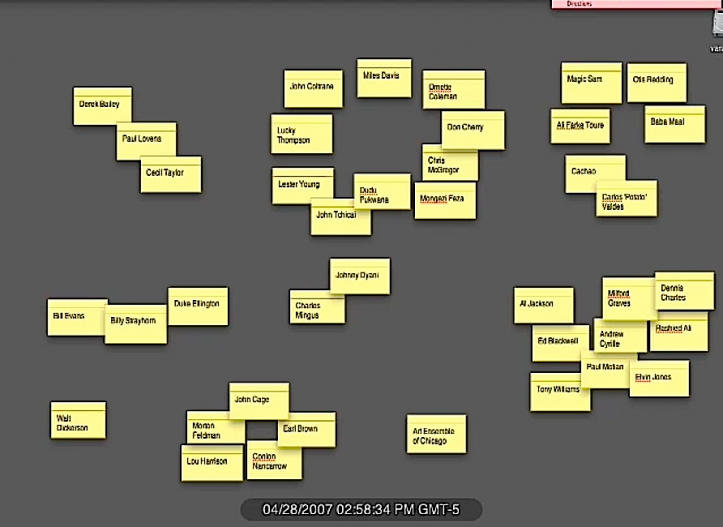
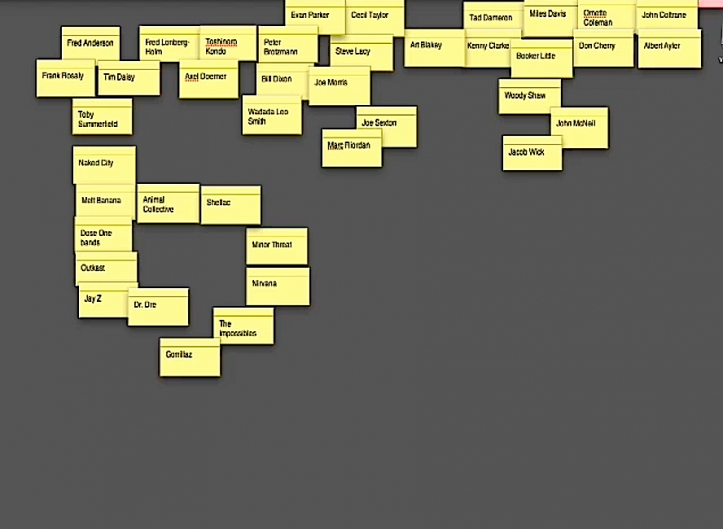

Part.1 Part. 2 Part. 3 Part. 4


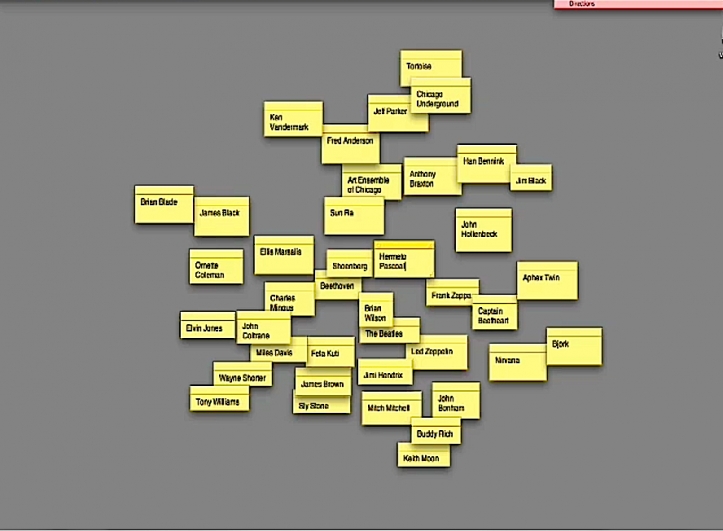

Part. 5 Part. 6 Part. 7 Part. 8


Part. 9 Part. 10
The arrangements are all visually diverse, and for each participant, multiple strategies were always simultaneously active. All the participants spoke of strict cluster boundaries, and the cards were only overlapping within clusters, suggesting that similarities only existed amongst a group of relative musicians. I coded some of the interview data to show how many participants implemented each strategy to arrange their cards.

Participant 10 used five very clear strategies to arrange his cards. Genre was the strategy he used to form the following clusters: Bebop [Monk, Parker, Powell, Rollins], funky music [Gaye, Brown, Jamerson], classical bass [Rotaru, Levinson], and modern jazz [Marsalis, Douglas, Osby]. Several clusters were defined by instrument: Saxophonists [Young, Konitz, Coltrane, Henderson], drummers [Haynes, Higgins, Joe Jones], vocalists [Baker, Sinatra], and bassists [Blanton, Chambers, Carter, Petiford, Garrison, Brown, Grenadier, Haden, Ware, and McBride]. You can tell this participant was a bassist! He grouped Blysma and Bach together as they relate to his classical upbringing. Coleman and Davis were grouped together for their forward-thinking sensibilities, and Ellington, Strayhorn, and Mingus were all influential composers. Freeman and Carroll were both influential musicians living in Chicago at the time of the interview (geographical placement). Only participant 5 used chronology as the sole strategy for arranging the cards, but almost all the participants organized their clusters with lineage and chronology in mind.
Overall, participants’ strategies reflected personal notions of what is valuable about the music they love. For example, participant 8 claimed, “[Monder and Messiaen] deal with harmonies that are very deep. People aren’t as honest about how good it has to sound…those two cats really hit it” – this excerpt shows how deeply concerned he is with complex harmony in performance. Strategies also reflect personal perceptions of hearing music a certain way: “I hear a difference between European and American improvisers” (participant 6), and “I don’t know if Wojo was actually heavily influenced by Wayne, but I hear it that way” (participant 9). Participants had a keen sense of knowing about chronology and collaborative activity: “Bill Frisell is a direct outgrowth of Jim Hall, because they both have a strong melodic sense and a humorous side to their playing” (participant 9), “Art Blakey is related to Cecil Taylor, they played jazz in the 50s, and Steve Lacy comes out of Cecil’s school, he played with him on Jazz Advance and was tremendously influenced by him” (participant 3), and “I always see the relationships. When I think about a specific musician, I think about where they come from or who they’ve played with, it’s a big descriptor of who the musician is” (participant 7). All the participants in this study exuded a strong confidence about their influences’ identities.
In another portion of the interview, I asked participants to talk about their communities – their sense of belonging to a group, general activities, and value systems for those groups. I believe there is a strong connection between cognition, value systems, and community in music, and there are a small group of researchers in music asking similar questions. Hasan Gürkan Tekman found that our identities are shaped by the music we prefer (Tekman & Hortacsu, 2002), and jazz musicians, in particular, are aware of their opinions, dress and language codes (Merriam & Mack, 1960; Monson, 1996). In this study, there was a range of feeling connected, partially due to differences in time spent in the community. Some participants saw communities developing, “I feel like I’m still assimilating into the community,” (participant 8) and “I feel like I’m on my way to creating my own little niche in that web, where I can be tied to lots of different things” (participant 9); while others felt strongly connected, “I feel pretty involved, I know a good amount of people, I don’t know as many as I’d like to, but the more you go out, you meet people all the time,” (participant 7) and “Yea there’s a core 10 musicians that I play with the most, but I’m always actively trying to branch out” (participant 1).
I also asked participants to guess their community members’ influences, and cross-checked for accuracy. Five participants referred to their own when guessing their collaborators’ influences, while the other five were quite accurate, but only with respect to influences that related to them by instrument. This implies that they expect musicians within their community to share aspects of their own musical identities, correlating with the literature on shared norms (e.g. isolation, language) in the jazz community (Merriam & Mack, 1960; MacDonald & Wilson, 2005).
As a unified community bound by geography, musicians in this study arranged their influences similarly, which reflects a shared mental representation for this facet of their lives. Most likely, musicians from other geographies would do the same (I’ve asked musicians in New York about their influences, and they have informally confirmed by hypotheses), so this research suggests that musicians have cultural conceptualizations for their influences. Medin’s lab showed similar results about fishing practice in Wisconsin, and with respect to the domain of kinship metaphors, Farzad Sharifian suggests that “…schemas and categories become the objects of interactions between the members of a given cultural group and as such emerge as aspects of distributed cultural cognition” (2008, p. 14). Thinking about music communities this way makes a lot of sense to me, because musicians are always talking to each other, traveling, and playing music for each other; the webs are so interconnected and new conceptualizations can shift from one zone to the other, depending on who’s playing with who.
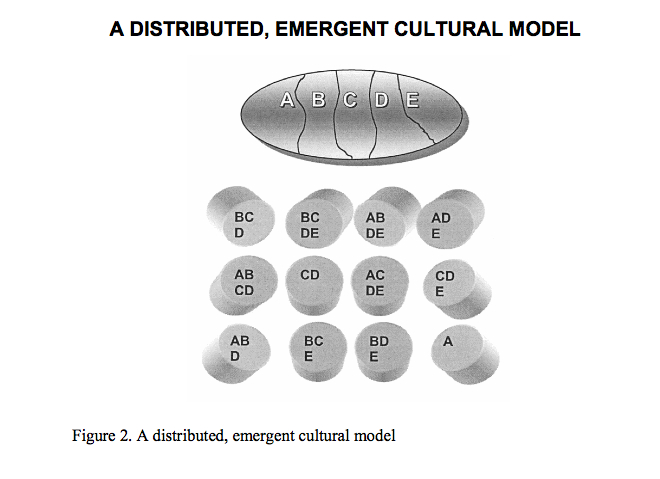
Sharifian (2011)
After this project, I took these ideas further, using social network analysis to find distinct communities in the Chicago jazz scene. I also asked new participants to talk about the same musicians and samples of music, so I could have more data-mining control. If you’re interested in this study, you can read it here.
I think techniques in cognitive psychology can offer a lot to the study of music, but we have to be careful to not lose our sense of what the music means to us as individuals. Kay Kaufman Shelemay put it poignantly in a paper several years ago: "Collaboration across boundaries of the sciences and humanities is inevitably complex, in part because scientists often deal with the grand sweep of evolutionary time while humanists study the (relatively) shorter durations of individual lifetimes or well-bounded historical epochs" (2011, p. 381).
Research in this domain has the potential to uncover deeper meaning systems and to push even further into the partner field of neuroscience. We may be able to track neural substrates of musical influence between performers, which may explain why musicians sometimes feel a sense of extrasensory perception when they play with others. Bridging the research boundaries between Ethnomusicology, Music Cognition, and Neuroscience is partially my goal for the future, and this study is only the beginning.
References
Anson-Davis, C. (2010). Semantic knowledge of eminent jazz performers: A study on the impact of community affiliation and expertise (Doctoral dissertation). Available from ProQuest Dissertations and Theses database. (UMI No. 3402721).
Berliner, P. (1994). Thinking in jazz. University of Chicago Press.
Liebman, D. (2011). The complete transcription process. DaveLiebman.com. Retrieved March 20, 2012, from http://www.daveliebman.com/earticles2.php?DOC_INST=13.
MacDonald, R.A.R., Hargreaves, D.J., & Miell, D. (Eds.). (2002). Musical identities. Oxford University Press.
MacDonald, R.A.R. & Wilson, G. (2005). Musical identities of professional jazz musicians: A focus group investigation. Psychology of music, 33(4), 395-417.
Medin, D.L & Atran, S. (2004). The native mind: Biological categorization, reasoning and decision making in development across cultures. Psychological Review, 111( 4), 960-983.
Medin, D.L., Ross, N., Atran, S., Cox, D., Coley, J., Proffitt, J., & Blok, S. (2006). Folkbiology of freshwater fish. Cognition, 99(3), 237-273.
Medin, D., Ross, N.O., & Cox, D. (2006). Culture and resource conflict: Why meanings matter. New York: Russell Sage Foundation.
Merriam, A.P. & Mack, R.W. (1960). The jazz community. Social Forces, 38(3), 211-22.
Monson, I. (1996), Saying something: Jazz improvisation and interaction. University of Chicago Press.
Sharifian, F. (2008). Distributed, emergent cultural cognition, conceptualization, and language. In R.S. Frank, R. Dirven, R. Ziemke, E. Bernardez (Eds.). Body, language, and mind (Vol. 2): Sociocultural situatedness. Berlin/New York: Mouton de Gruyter.
Shelemay, K.K. (2011). Rethinking the collective in music. Journal of the American Musicological Society, 64(2), 349-390.
Unsworth, S.J. & Medin, D.L. (2005). Cross cultural differences in belief bias with deductive reasoning? Cognitive Science, 29(4), 525-529.
Tekman, H.G. & Hortacsu, N. (2002). Music and social identity: Stylistic identification as a response to musical style. International Journal of Psychology, 37(5), 277-285.
Caroline Davis is a saxophonist and vocalist living in Brooklyn, New York. She maintains an active performing schedule in several bands, most notably her own soul/R&B group, Maitri and collaborative jazz trio, Whirlpool. In addition, Caroline teaches Psychology of Music for DePaul University in Chicago, and Music Together for families at Eastside Westside and Music Together in the City in New York City.
www.carolinedavis.org
@maitrimusic





